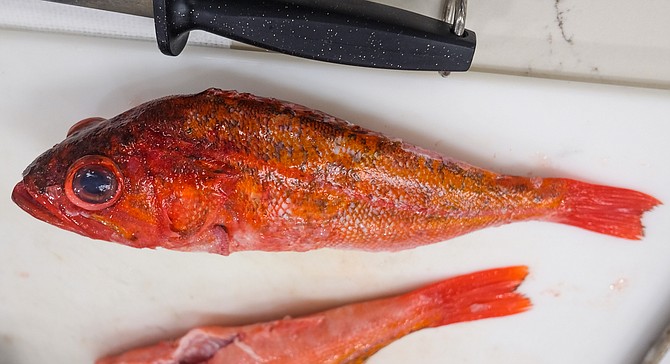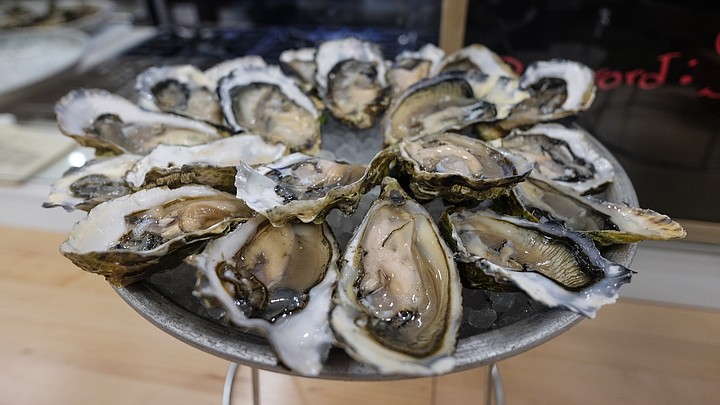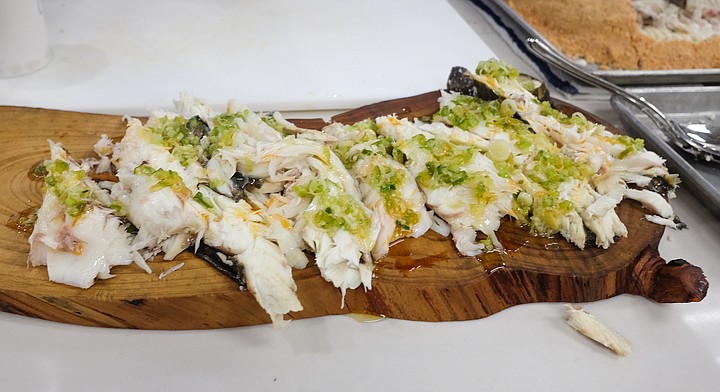 Facebook
Facebook
 X
X
 Instagram
Instagram
 TikTok
TikTok
 Youtube
Youtube

I finally learned how to filet a fish. At least, I was taught.
I eat seafood often, but I’m not in the habit of preparing it at home. I get uncomfortable handling it, as though it were a too delicate thing that my clumsy hands will destroy. In that sense, attending a recent class on Sustainable Seafood might have been just the inspiration I needed to pick up a sharp knife, and get better acquainted with San Diego’s local catch.

The $25 class took place in Studio Kitchen, an instructional kitchen housed inside the restaurant supply warehouse, Specialty Produce, where it was produced by the Berry Good Food Foundation, a regional charity founded in part to encourage us to eat food harvested locally.

Led by Ironside Fish & Oyster founding partner and chef Jason McCleod, the first portion of the class included a discussion on the importance of knowing where our seafood comes from, and who’s been handling it. Local fisherman Kelly Fukushima was on hand to provide insights into the breadth of seafood harvested from local fisheries, which may provide over a hundred different species over the course of a year, including lesser known fish that taste great on a plate, such as sheephead, rockfish, and thresher shark.

The prevalence and sustainability of such fish delivered directly to the restaurant by local fishermen is why, McLeod explained, Ironside can generally afford not to serve America’s most popular fish: salmon. Local halibut does turn up frequently on the other hand, and the acclaimed chef demonstrated an easy way to prepare it: baked in salt. As we watched, he encased an entire fish in a mixture of kosher salt and egg whites, then salt-baked it about 30 minutes at 450 degrees.
We students would eventually get to taste the succulent results, but first we noshed on plenty of delicious food provided by Ironside, including ceviche, seared sashimi, and oysters in a half shell.
All that food on its own was well worth the price of admission, but the highlight for me came when Ironside chef de cuisine Mike Reidy demonstrated both filet and butterfly techniques, using rockfish. In his expert hands, the knifework did not seem nearly as intimidating as I’d imagined, mostly leveraging the flat side of the knife against flat surfaces and bone. Yes, I will be trying it at home.
Likewise, gaining a better understanding of what a rockfish looks like made me much more likely to search for it on a menu. The chefs compared the small red fish to red snapper, and there’s a chance that, if you’ve ordered red snapper in local restaurants, it might have been rockfish. As with many fish varieties marketed as some form of sea bass or cod, lending it the name of a better-known fish makes it an easier sell. Because, while most diners know there are plenty of fish in the sea, we tend to only know the names of a few. If we get hung up on those, we will miss out on myriad great flavors and textures.
Oh, the things you can learn on a Sunday morning. Keep an eye on Berry Good Foundation events to catch on to its continuing educational series. Previous chef-taught classes have included making tomato preserves, cheese, and fresh pasta.


I finally learned how to filet a fish. At least, I was taught.
I eat seafood often, but I’m not in the habit of preparing it at home. I get uncomfortable handling it, as though it were a too delicate thing that my clumsy hands will destroy. In that sense, attending a recent class on Sustainable Seafood might have been just the inspiration I needed to pick up a sharp knife, and get better acquainted with San Diego’s local catch.

The $25 class took place in Studio Kitchen, an instructional kitchen housed inside the restaurant supply warehouse, Specialty Produce, where it was produced by the Berry Good Food Foundation, a regional charity founded in part to encourage us to eat food harvested locally.

Led by Ironside Fish & Oyster founding partner and chef Jason McCleod, the first portion of the class included a discussion on the importance of knowing where our seafood comes from, and who’s been handling it. Local fisherman Kelly Fukushima was on hand to provide insights into the breadth of seafood harvested from local fisheries, which may provide over a hundred different species over the course of a year, including lesser known fish that taste great on a plate, such as sheephead, rockfish, and thresher shark.

The prevalence and sustainability of such fish delivered directly to the restaurant by local fishermen is why, McLeod explained, Ironside can generally afford not to serve America’s most popular fish: salmon. Local halibut does turn up frequently on the other hand, and the acclaimed chef demonstrated an easy way to prepare it: baked in salt. As we watched, he encased an entire fish in a mixture of kosher salt and egg whites, then salt-baked it about 30 minutes at 450 degrees.
We students would eventually get to taste the succulent results, but first we noshed on plenty of delicious food provided by Ironside, including ceviche, seared sashimi, and oysters in a half shell.
All that food on its own was well worth the price of admission, but the highlight for me came when Ironside chef de cuisine Mike Reidy demonstrated both filet and butterfly techniques, using rockfish. In his expert hands, the knifework did not seem nearly as intimidating as I’d imagined, mostly leveraging the flat side of the knife against flat surfaces and bone. Yes, I will be trying it at home.
Likewise, gaining a better understanding of what a rockfish looks like made me much more likely to search for it on a menu. The chefs compared the small red fish to red snapper, and there’s a chance that, if you’ve ordered red snapper in local restaurants, it might have been rockfish. As with many fish varieties marketed as some form of sea bass or cod, lending it the name of a better-known fish makes it an easier sell. Because, while most diners know there are plenty of fish in the sea, we tend to only know the names of a few. If we get hung up on those, we will miss out on myriad great flavors and textures.
Oh, the things you can learn on a Sunday morning. Keep an eye on Berry Good Foundation events to catch on to its continuing educational series. Previous chef-taught classes have included making tomato preserves, cheese, and fresh pasta.
Comments